Evaluating Medical Books You Want to Sell
Topics: evaluating, Medical textbooks, Civil War
medical books, Antique medical books, Rare medical books
Pre-1865
medical textbooks marked 'U.S. Army Hospital or
Medical Department, USA Hosp. Dept., USA Medical Dept.
The principle differentiation for a Civil War era
medical book from any other medical book is topic, author, dates
published, publisher, who ordered the books published, i.e. the U. S.
Army Medical or Hospital departments, and the condition.
See:
Collecting Civil War
medical books
First and foremost, TAKE digital
photos of your book. Without photos of the outside covers, the
spine, and title pages, it is almost impossible to evaluate
a book. Look at these various photos to get an idea of what one needs
to see to help you:
Click on any image to
enlarge



The details on the title page are
extremely important and must be in focus to be readable, I have to be
able to see the author, publisher and above all the date
of publication





The hinge of the
front cover should be visible, as well as the
outside of the covers (boards) and the spine with
the name. Show any defects or damage to pages
such as water stains. See a list of defects
below.
Book evaluations and valuations are
very subjective. Just because a book is 150 years old doesn't mean
it can't be in very good or fine condition. Age is not an excuse
for poor condition, but abuse is. If a book has been left in a wet
and unprotected environment (a basement) for years, it's going to be in
pretty poor condition as opposed to it having been carefully preserved
in a library. Values vary greatly due to rarity, condition,
authors, topic, version, date, etc. We can discuss all this if you
provide the digital or print photos of your books.
Condition Description Definitions
of pre-1865 books
FINE:
Not crisp.
May have been carefully read and covers may have been slightly
rubbed or spine ends slightly bumped from shelving/shipping, but no
real defects or faults. 19th century or earlier,
slightly more signs of usage are tolerated, but still a
well-cared-for, fresh looking book — very minor rubbing , very minor
fading of cloth or color of boards, but no cracked hinges, a few
specks of foxing, nothing missing — no missing endpaper, half-title
or spine labels. In both the 20th century and the earlier book,
there should not be any library markings (public or institutional),
however there may be a bookplate from a private collector
VERY GOOD:
A used book showing some small
signs of wear on either binding. Any defects/faults must be noted.
19th century or earlier, minor rubbing of extremities is expected,
no chipping (missing material) at top or bottom of spine, no signs
of major fraying of cloth, no cracked hinges or cracked joints,
possibly minor spots of soil or stain and occasional foxing (rust
colored spots) is
expected — nothing should be missing, no missing endpaper or
half-title. A very good copy can be ex-library with library
markings, but should be so described and with few exceptions the
ex-library copy would not be a desirable book to add to your
collection
GOOD:
The average used and worn book that has
all pages or leaves present. Any defects must be noted. An
earlier book showing average use and wear, but not in need of a
replacement binding, not all tattered & torn, not with moderate to
heavy damp stain, basically still intact but worn, spine extremities
can show minor chipping, corners can all be bumped, and (there is
disagreement here) in the case of an earlier book a free endpaper,
or other blank page such as a flyleaf, can be missing, a hinge can
be cracked ( the book should not be in need of recasing — with the
covers barely attached), there can be moderate to heavy foxing in
earlier books, a good copy should be a book that has seen
average/considerable use and is added to your collection because you
care more about the content of the book than the condition or you
hope someday to upgrade to a better copy of the same book
FAIR:
A worn book that has complete text
pages (including those with maps or plates) but may lack endpapers,
half-title page, etc. (which must be noted). Binding, cover etc. may
also be worn. All defects/faults must be noted. A fair copy may
exhibit moderate to heavy dampstain, excessive stain or foxing in
the text, a very tattered cloth or very scuffed and rubbed leather
binding with additional problems such as underlining in the text,
lacking endpapers, both hinges cracked, heavy dogearring of page
corners — in general only a step above a reading copy and not a
desirable copy unless you value content much more than condition
POOR or READING COPY:
A book that is
sufficiently worn that its only merit is the complete text, which
must be legible. Any missing maps or plates should still be noted.
May be soiled, scuffed, stained, or spotted, and may have loose
joints, hinges, pages, etc.
EX-LIBRARY:
Must always be designated as
ex-library such no matter what the condition of
the book. Most of these old library books have the white marking ink
on the spine of the book and cards or pockets on the inside from
library usage. It really hurts the value of the book greatly
due to abuse and use over many years and ex-library books are not wanted for this
collection.
Book size:
Height, width, and thickness of the book. (i.e. 5 x 7
x 1/2 in.)
Describing defects:
- Bumped edges or corners bent. Someone set this
book down too hard on one or more of its corners or edges is
bent or broken.
- Foxing or foxed. Light brown or rust colored
spotting on the pages.
- Scuffed or rubbed marks on the covers (boards)
of the book that look a lot like the scuff marks on shoes, but
usually not so severe.
- Cut and loose leather
or cloth covering.
- Water stains. Irregular water marked pages or covers
of the book. Mildew may be present too, if so it should be
noted.
- Detached pages or missing pages.
- Shaken pages. Groups of pages are loose or out of
alignment from the binding, usually due to the back of the
binding being loose. There are splits in the gutter
between pages.
- Broken hinge. The page is broken down in
the gutter so you can see into the spine of the book. See
examples at bottom of this page.
- Chipped or missing parts of the spine (back edge of the book
on which the name is printed)
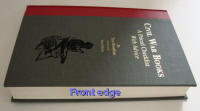
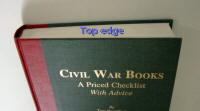
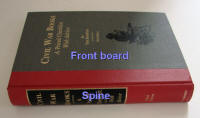
Front edge Top
edge
Front board or cover and Spine
The front or back 'board' and the front or
back 'cover' are interchangeable terms
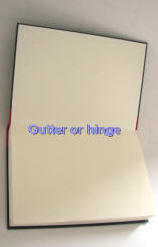
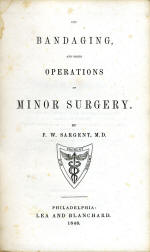
Gutter or hinge
Title page
Defects
|
Water stain along side of title page
Scuffing of exterior leather cover |
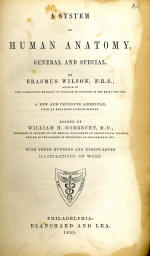 |
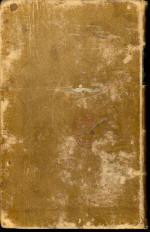 |
|
Pages separated
Broken
hinges |
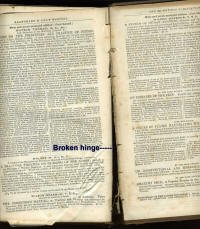 |
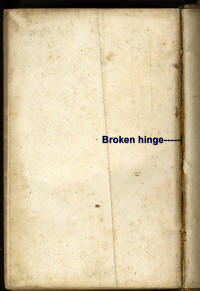 |
|
Broken front hinge
Page
split from binding |
 |
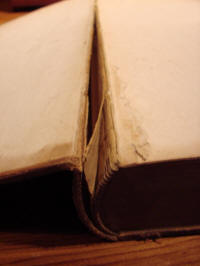 |
|
Water stain at bottom of board
Missing or chipped top edge of spine |
 |
 |
|
Insect damage on spine and edges of a
cloth covered textbook |
 |
|
|







